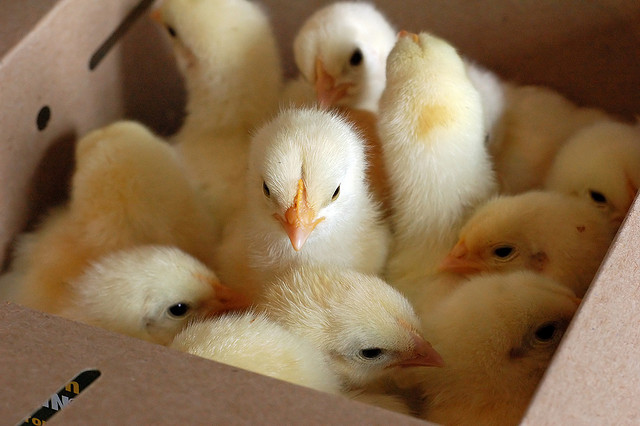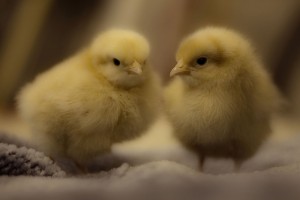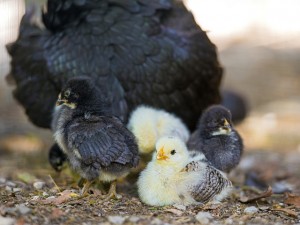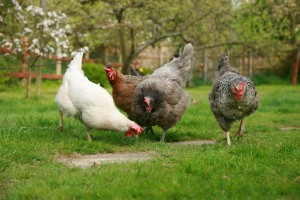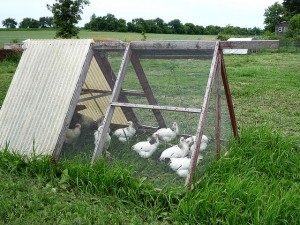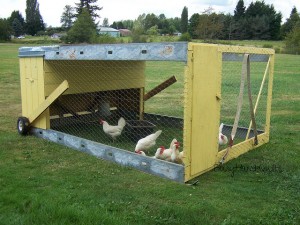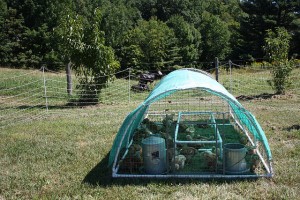It is always gratifying to get feedback and interaction from the Urban Chicken Podcast audience. Recently, Carla Allen of Georgia email me and posed a few questions that were interesting and applicable to all chicken keepers. Her questions are in the area of chicks, flocks, and tractors. This week’s episode is a questions and answers session.
Urban Chicken Podcast listener Carla posed three questions that are personal to her situation and family, but which also are relevant to all backyard chicken keepers. Here is what she wrote:
Jen:
You can’t imagine how helpful & inspiring your podcast has been to me! It makes my 35 min commute to work much more enjoyable! We bought a home last year with a coop & run already completed so chickens were our next step. We got 7 hens (Amerucauna-Rhode Island Red mix) and 1 rooster (Amerucauna). They were already a year old when we got them & I have thoroughly enjoyed the fresh eggs & chicken interactions I’ve observed. They however came from a large farm so they are not “pets” but layers. I’m enjoying learning more about them each day.
We are thinking of getting chicks in the spring. My daughters (ages 6, 12, & 14) want specific breeds, now that we know a little more, and so do I. Where are the best places to get chicks? What are strategies to introduce new chickens to an established flock? My daughter also wants to possible show a chicken in the future.
I am also curious about the advantages & disadvantages to a chicken tractor. We live on 4 acres of mostly grass. We have the current flock in a fairly large run but they have eaten it down to no grass 🙁 I am planning to install a “salad bar” after reading about these on BYC forum but was thinking for the “babies” in the spring that a tractor might also be an option. We live close to a wood line so free-ranging is not really an option.
Thanks for all that you share & do! LOVE the Podcast so keep it coming!
Thank you to Carla for listening and sending me these questions to answer. I am really flattered and touched by her email. Let’s answer these questions:
Question No. 1: Where are the best places to get chicks?
It depends on what you want the chickens to do for you. If you just want a few egg-layers in the backyard and don’t mind whether they are poor specimens for their breed, then the easiest answer is down at the local feed store. However, if you are more particular about quality or would like to raise some unusual breeds, then I would suggest buying from small, private breeders who also show their chickens competitively.
In Carla’s case, for example, she needs chickens that her daughters could reasonably use as show birds for competition. The likelihood of buying a chick at the local feedstore or from a large hatchery that will be up to quality is quite slim – maybe one in a few hundred of these chicks could be shown competitively. However, with a little research, Carla could buy chicks from a small scale, specialty breeder or hatchery for a much better chance of getting a quality bird. Buying from a decent, small-scale breeder, Carla’s chances of getting a show quality bird go up to one in ten.
Aren’t chicks from a small specialty breeder more expensive to buy than the ones at the feedstore? Absolutely – but you get what you pay for. Also, the price difference might not be as great as you’d think. Chicks from the feedstore are going to cost approximately $1-$3/per chick. However, if you can find a local, specialty breeder in your area, their day old chicks likely will cost $7-20/per chick. Chicks bought from the specialty breeder are more money initially. However, it is false economy to buy cheap, sub-par chicks when ultimately they cost the same in feed and care as their better quality counterparts. Why spend $2 dollars on a chick that is so poorly bred that it will not pass even the minimal qualifications to compete at show, when an up-front investment of $10-20 dollars in a good quality stock chick will likely provide a bird that can be a contender.
Be warned though – not all small breeders produce high quality birds. The best way to tell if a breeder produces quality birds is if they competitively show their stock. Breeders who win at competition likely breed good birds. You can search for small-scale, quality breeders/hatcheries in the back section of the Backyard Poultry Magazine and also in the Poultry Press newspaper, or other poultry journals. You could also inquire with the local poultry club in your area for the names of accomplished local breeders and small hatcheries.
Question No. 2: What are some useful strategies to introduce new chickens into an established flock?
Adding new chickens to an established flock always ruffles feathers. New birds mean one thing – a change to the pecking order. All flocks have a hierarchical order in which every bird knows their respective rank. New flock members have to be absorbed into the pecking order and inevitably will change the rankings of some birds. Oddly, it is often the lowest birds in the pecking order than can be the cruelest to new members. I suspect this cruelty from flock underlings is based in hopes of moving up in the pecking order with newer chickens ranking beneath them. Consequently, whenever new chickens are added to a flock, bullying and pecking must happen as they rework out the pecking order. There are however, a few tricks to helping make the transition of new birds to a flock less traumatic.
First, never add a single chicken to an established flock. New birds need a compatriot and someone to share the brunt of the flock’s attacks. A bird added by itself to a flock, is more susceptible to being more badly abused as an intruder and less likely to be well accepted ever.
Add new flock members at night. Chickens do better when they wake up and there just happens to be new birds in the coop. Were those birds always there? It’s a mystery. Dumping new birds midday into an active flock is a good way to get them seriously attacked. Remember, chickens are sort of like gangs – very territorial and very intolerant of perceived rivals.
If you are adding young birds to a mature flock, wait as long as possible to add the new pullets and cockerels – until they are large enough to defend themselves. Though you can put new birds outside to live by age 4-5 weeks old, a bird this age will be way too small to fend off the abuse it is going to receive from the grown flock members. Consider keeping young birds in a coop or tractor outside separate from the main flock until they grow a lot bigger.
Lastly, when mixing in new chickens to the flock, I have found it to be effective to let all the birds free-range together those initial days. Allowing the birds to free-range together gives the new chickens the ability to effectively escape severe pecking from the bigger and established hens. In a coop there are few places for new birds to flee to. Free-range introduction to the flock reduces injuries to the new members as the pecking order gets worked out.
Question No. 3: What are the advantages and disadvantages of a chicken tractor?
There are several advantages to using a chicken tractor. First, they allow the flock to be let out on grass and safe from predators at the same time. Tractors also make it possible for the flock to work different parts of the yard by positioning this mobile coop in various parts of the yard for a few days at a time. This ensures that all of the lawn gets fertilized and yet not over-scratched.
Secondly, chicken tractors can fulfill the needs of the owners better than a permanent, fixed coop. Chicken tractors are, on the whole, much easier to build and a less expensive option than a full coop and run. Depending on the layout of your home and yard, there may not be a good place to erect a permanent coop and a tractor solves that problem by simply moving the flock systematically through the yard. Additionally, if you are renting your home, a chicken tractor provides chicken owners a way to house their birds and not lose that investment when they move.
Lastly, having a chicken tractor can be a nice compliment to a permanently fixed coop. In Carla’s situation, where she will be adding new, young birds to the established flock currently living in her permanent coop, a tractor would allow her young birds some time outside and time to grow large enough to protect themselves from the inevitable hen-pecking they will receive when they are added to the main flock.
There are some significant disadvantages to chicken tractors too. A chicken tractor that is not thoughtfully constructed can be very cumbersome and not function as intended. My sister and I built my chicken tractor from our own design. Though it is cute enough, my tractor has some serious design flaws. First, we were not careful about the weight, and as a result, my chicken tractor is stupidly heavy! Being so heavy, it requires more than one person to move.
Secondly, a poorly designed tractor can be uncomfortable for your birds. My sister and I built an A-frame design with the coop/housing portion being on one end. Honestly, this design has problems. By putting all of the “coop” portion of the tractor on one end, I was forced to put the roost bars up in the top part of the A Frame. It is hard for the birds to fly up to the bars and it is cramped for them with little head room once they are up there. I have seen other A-frame tractor designs on-line (which are often called Arks). In these chicken arks, the nesting area runs the entire top length of the A-framed tractor. This design better distributes the weight of this moveable coop, but I suspect (I can’t say for sure since I have never used a chicken ark) that it would still create cramped quarters for your birds. If I had to build a chicken tractor again I would make in rectangular in shape so that there would be a better use of living space for the birds.
You need to carefully consider, when building a chicken tractor, where you’re going to put the door or doors. Badly placed doors make for a more difficult time for the chicken keeper. Inevitably you are going to need to reach into your tractor and remove a bird. Depending on how you place your tractor doors, that is either an easy or difficult task. My tractor’s design made it a difficult task. When I open one of the two outer doors on my tractor, the chickens simply run away from me by either going into or out of their living quarters. Sadly, this runaway tactic is facilitated by another design flaw in the tractor – the small gangplank door to their living space doesn’t really close. So they are easily able to put a wall between my snatching hand and themselves. I have had to crawl inside my tractor on more occasions than I care to think about to get a certain chicken out. Crawling inside a lived in tractor (think lots of chicken poop) on your knees, is not a dream.
Lastly, if you live in a cold climate, a chicken tractor may be insufficient for the birds’ needs. In an effort to keep the tractor’s overall weight down, it is common for the structure to completely lack insulation or to be airy. Chickens need well-built structures that provide them proper cover from the snow and cold so they don’t get frostbite and general suffer in the cold.
Here is a video of the chicken tractor my sister and I built – cute and flawed. We ripped down pallets to usable lumber for this project.
CHICKEN NEWS:
- Greenville On-line – Chicken Eggs Aid Birth Defect Research – ARTICLE
- Tigernet – Clemson Research Finds Chickens Aid in Birth Defects Research LINK
- Clemson University – FB page for Clemson’s Research & Extension LINK
- Clemson News – Twitter Feed LINK
- The Newsstand – Chickens Offer Clues to Human Birth Defects – ARTICLE
MAIN SEGMENT:
- Poultry Press – A Very Good Resource for Chicken News and Finding Quality Breeders and Small Hatcheries – Poultry Press
- Backyard Poultry Magazine – Another Great Resource for Chicken News and Finding Quality Breeders and Small Hatcheries – Backyard Poultry
- My Pet Chicken – Introducing New Chickens to the Flock – LINK
- British Hen Welfare Trust – Merging and Establishing a New Flock ARTICLE
- Backyard Chickens – The Pros and Cons of Using a Chicken Tractor ARTICLE
Podcast: Play in new window | Download | Embed
Subscribe: Apple Podcasts | RSS

